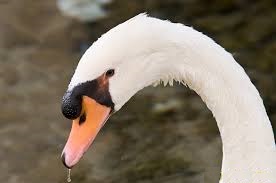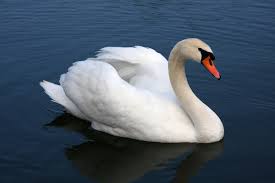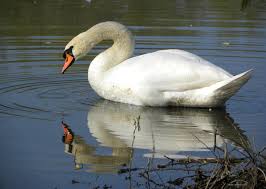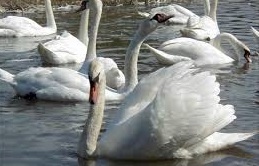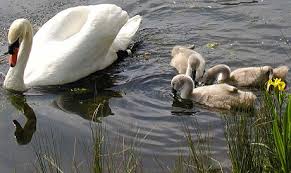The mute swan is a species of swan and a member of the waterfowl family Anatidae. It is native to much of
Europe and Asia, and (as a rare winter visitor) the far north of Africa. It is an introduced species in North
America, Australasia and southern Africa. The name 'mute' derives from it being less vocal than other swan
species. Measuring 125 to 170 cm (49 to 67 in) in length, this large swan is wholly white in plumage with an
orange beak bordered with black. It is recognisable by its pronounced knob atop the beak, which is larger in
males.
Description
Adults of this large swan typically range from 140 to 160 cm (55 to 63 in) long, although can range in
extreme cases from 125 to 170 cm (49 to 67 in), with a 200 to 240 cm (79 to 94 in) wingspan. Males are larger
than females and have a larger knob on their bill. On average, this is the second largest waterfowl species
after the trumpeter swan, although male mute swans can easily match or even exceed a male trumpeter in mass.
Among standard measurements of the mute swan, the wing chord measures 53-62.3 cm (20.9-24.5 in), the tarsus
is 10-11.8 cm (3.9-4.6 in) and the bill is 6.9-9 cm (2.7-3.5 in).
The mute swan is one of the heaviest flying birds. In several studies from Great Britain, males (known as
cobs) were found to average from about 10.6 to 11.87 kg (23.4 to 26.2 lb), with a weight range of 9.2-14.3
kg (20-32 lb) while the slightly smaller females (known as pens) averaged about 8.5 to 9.67 kg (18.7 to 21.3
lb), with a weight range of 7.6-10.6 kg (17-23 lb). While the top normal weight for a big cob is roughly 15
kg (33 lb), one unusually big Polish cob weighed almost 23 kg (51 lb) and this counts as the largest weight
ever verified for a flying bird, although it has been questioned whether this heavyweight could still take
flight.
Young birds, called cygnets, are not the bright white of mature adults, and their bill is dull greyish-black,
not orange, for the first year. The down may range from pure white to grey to buff, with grey/buff the most
common. The white cygnets have a leucistic gene. Cygnets grow quickly, reaching a size close to their adult
size in approximately three months after hatching. Cygnets typically retain their grey feathers until they
are at least one year old, with the down on their wings having been replaced by Flight feathers earlier that
year.
All mute swans are white at maturity, though the feathers (particularly on the head and neck) are often
stained orange-brown by iron and tannins in the water.
The morph immutabilis ("Polish swan") has pinkish (not dark grey) legs and dull white cygnets; as with white
domestic geese, it is only found in populations with a history of domestication. Polish swans carry a copy
of a gene responsible for leucism.
Distribution and habitat
The mute swan is found naturally mainly in temperate areas of Europe across western Asia, as far east as the
Russian Maritimes, near Sidemi.
It is partially migratory throughout northern latitudes in Europe and Asia, as far south as north Africa and
the Mediterranean. It is known and recorded to have nested in Iceland and is a vagrant to that area, as well
as to Bermuda, according to the UN Environment Programme chart of international status chart of bird species,
which places it in 70 countries, breeding in 49 countries, and vagrant in 16 countries. While most of the
current population in Japan is introduced, mute swans are depicted on scrolls more than a thousand years
old, and wild birds from the mainland Asian population still occur rarely in winter. Natural migrants to
Japan usually occur along with whooper and sometimes Bewick's swans.
The mute swan is protected in most of its range, but this has not prevented illegal hunting and poaching.
It is often kept in captivity outside its natural range, as a decoration for parks and ponds, and escapes
have happened. The descendants of such birds have become naturalised in the eastern United States and Great
Lakes, much as the Canada goose has done in Europe.
Behavior
Mute swans nest on large mounds that they build with waterside vegetation in shallow water on islands in the
middle or at the very edge of a lake. They are monogamous and often reuse the same nest each year, restoring
or rebuilding it as needed. Male and female swans share the care of the nest, and once the cygnets are
fledged it is not uncommon to see whole families looking for food.They feed on a wide range of vegetation,
both submerged aquatic plants which they reach with their long necks, and by grazing on land. The food
commonly includes agricultural crop plants such as oilseed rape and wheat, and feeding flocks in the winter
may cause significant crop damage, often as much through trampling with their large webbed feet, as through
direct consumption.
Unlike black swans, mute swans are usually strongly territorial with just a single pair on smaller lakes,
though in a few locations where a large area of suitable feeding habitat is found they can be colonial. The
largest colonies have over 100 pairs, such as at the colony at Abbotsbury Swannery in southern England, and
at the southern tip of Öland Island, Ottenby Preserve, in the coastal waters of the Baltic Sea, and can have
nests spaced as little as 2 m (7 ft) apart. Non-mated juveniles up to 3-4 years old commonly form larger
flocks, which can total several hundred birds, often at regular traditional sites. A notable flock of
non-breeding birds is found on the River Tweed estuary at Berwick-upon-Tweed in northeastern England, with
a maximum count of 787 birds. A large population exists near the Swan Lifeline Station in Windsor, and live
on the Thames in the shadow of Windsor Castle. Once the adults are mated they seek out their own
territories and often live close to ducks and gulls, which may take advantage of the swan's ability to
reach deep water weeds, which tend to spread out on the water surface.
The mute swan is less vocal than the noisy whooper and Bewick's swans; they do, however, make a variety of
grunting, hoarse whistling, and snorting noises, especially in communicating with their cygnets, and usually
hiss at competitors or intruders trying to enter their territory. The most familiar sound associated with
mute swan is the vibrant throbbing of the wings in flight which is unique to the species, and can be heard
from a range of 1 to 2 km (0.6 to 1 mi), indicating its value as a contact sound between birds in flight.
Cygnets are especially vocal, and communicate through a variety of whistling and chirping sounds when
content, as well as a harsh squawking noise when distressed or lost.
Mute swans can be very aggressive in defence of their nests. Most defensive attacks from a mute swan begin
with a loud hiss and, if this is not sufficient to drive off the predator, are followed by a physical
attack. Swans attack by smashing at their enemy with bony spurs in the wings, accompanied by biting with
their large bill. The wings of the swan are very powerful, though not strong enough to break an adult man's
leg, as said anecdotally. Large waterfowl, such as Canada geese, (more likely out of competition than in
response to potential predation) may be aggressively driven off, and mute swans regularly attack people who
enter their territory. The cob is responsible for defending the cygnets while on the water, and will
sometimes attack small watercraft, such as canoes, that it feels are a threat to its young. The cob will
additionally try and chase the predator out of his family territory, and will keep animals such as foxes
and raptors at bay. In New York (outside its native range), the most common predators of cygnets are
common snapping turtles. Healthy adults are rarely predated, though canids such as coyotes, felids such as
lynxes, and bears can pose a threat to infirm ones (healthy adults can usually swim away from danger unless
defending nests) and there are a few cases of healthy adults falling prey to golden eagles. In England,
there has been an increased rate of attacks on swans by out-of-control dogs, especially in parks where the
birds are less territorial. This is considered criminal in British law, and the birds are placed under the
highest protection due to their association with the Monarch.
The familiar pose with neck curved back and wings half raised, known as busking, is a threat display. Both
feet are paddled in unison during this display, resulting in more jerky movement. The swans may also use the
busking posture for wind-assisted transportation over several hundred meters, so-called windsurfing.
Breeding
Mute swans lay an average of four eggs, and the female broods for 36 days. The cygnets do not reach the
ability of flight before an age of 120 to 150 days: this limits the distribution of the species in the
northern edge of its range, as the cygnets must learn to fly before the waters freeze.



